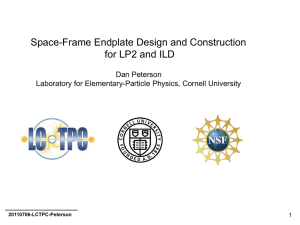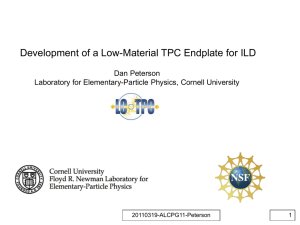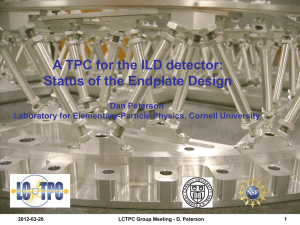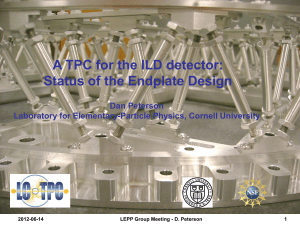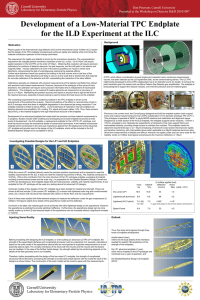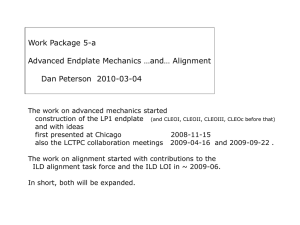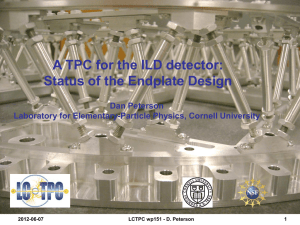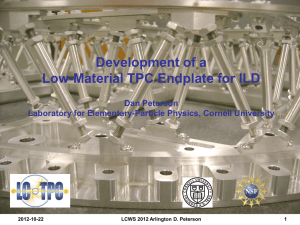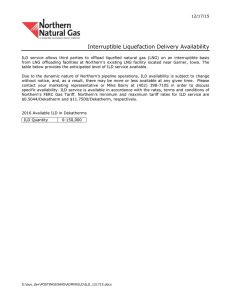Advanced Endplate - mechanics: Dan Peterson Laboratory for Elementary-Particle Physics, Cornell University
advertisement
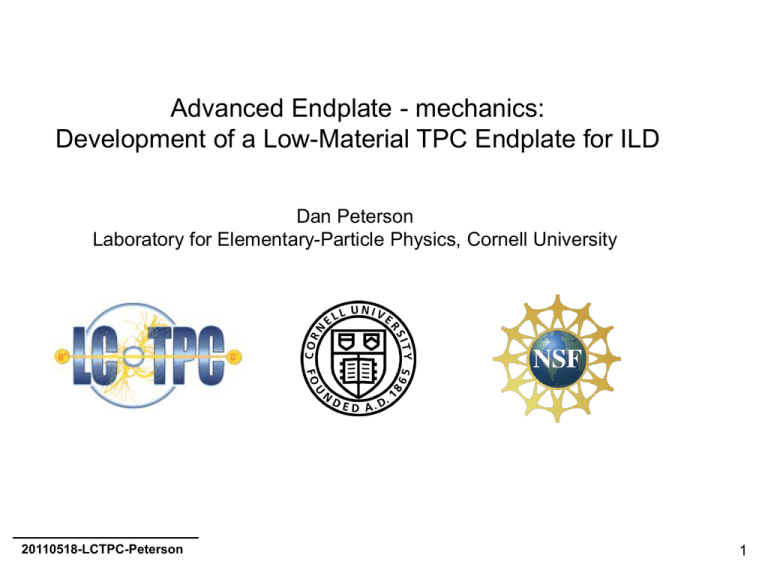
Advanced Endplate - mechanics: Development of a Low-Material TPC Endplate for ILD Dan Peterson Laboratory for Elementary-Particle Physics, Cornell University 20110518-LCTPC-Peterson 1 The ILD central tracker is a TPC with outer radius 1808 mm inner radius 329 mm half length 2350 mm Reporting on R&D toward the mechanical endplate of the ILD TPC which, along the way, involves a new endplate for the LCTPC LP1 and other small prototypes. 20110518-LCTPC-Peterson 2 Goals of the ILD TPC endplate Detector module design: Endplate must be designed to implement Micro Pattern Gas Detector (MPGD) readout modules. Modules must provide near-full coverage of the endplate. Modules must be replaceable without removing the endplate. Low material - limit is set by ILD endcap calorimetry and PFA: 25% X0 including readout plane, front-end-electronics, gate 5% cooling 2% power cables 10% mechanical structure 8% Rigid - limit is set to facilitate the de-coupled alignment of magnetic field and module positions. Precision and stability of x,y positions < 50μm Thin - ILD will give us 100mm of longitudinal space between the gas volume and the endcap calorimeter. 20110518-LCTPC-Peterson 3 In 2008, Cornell constructed two endplates for the LCTPC Large Prototype (LP1). These were shipped August 2008 and February 2010, and are currently in use. Inside the chamber Outside the chamber The endplate construction was developed to provide the precision required for ILD, precision features are accurate to ~30 μm, but not to meet the material limit specified for the ILD TPC; the bare endplate has mass 18.87 kg over an area of 4657 cm2, (mass/area) / (aluminum radiation length (24.0 g/cm2) ) = 16.9% X0, 2x the goal. The accuracy was achieved with a 5-step machining process developed at Cornell. 20110518-LCTPC-Peterson 4 The ILD endplate design is a space-frame and shown here as the solid model used for the Finite-Element-Analysis (FEA). (inside view) This is the “equivalent-plate” design space-frame; the separating members are thin plates. This design has rigidity and material equivalent to a strut design, which has also been studied. (More on that later.) This model has a full thickness of 100mm, radius 1.8m, and a mass of 136 kg. The material thickness is then 1.34g/cm2, 6% X0. 20110518-LCTPC-Peterson 5 FEA calculations of deflection and stress (stress is not shown) Endplate Support: outer and inner field cages deflection=0.00991 mm/100N 100N is the force on LP1 due to 2.1 millibar overpressure (area of ILD)/(area of LP1) =21.9 deflection for 2.1 millibar overpressure on the ILD TPC endplate (2200N) = 0.22 mm Without the space-frame structure, the simple endplate deflects by 50mm. rigidity vs thickness It was expected that the strength could be improved by asking ILD for more longitudinal space. However, the improvement with thickness diminishes (deviates from power law) above 100mm. Note small buckling in inner layer. Rigidity is improved with modest increase in the back-plate thickness. 20110518-LCTPC-Peterson 6 This ILD endplate design results from several studies: LP1 current endplate, measurements and FEA LP1 space-frame designs, FEA of models, small test beams, FEA and measurements. Future studies will include construction and measurements using a new LP1 endplate. “strut” space-frame design LP1 2008 endplate “equivalent plate” space-frame design 20110518-LCTPC-Peterson small test beams that represent one diameter of the LP1 endplate 7 In the first validation of the FEA, deflection of the current LP1 endplate was measured and compared to the FEA. The load of 100N (22lbs) was placed “uniformly” in the center module location. Deflection, measured across 2 lines, agrees on average. location number 7 6 5 4 20110518-LCTPC-Peterson 3 2 1 0 -1 “deflection 1” -2 -3 -4 Stress is <1% yield. -5 -6 -7 “deflection 2” 8 Various LP1 models were compared. mass kg LP1 18.87 16.9 33 1.5 8.93 8.0 68 3.2 Al 7.35 C 1.29 7.2 (68-168) (3.2-4.8) Al 7.35 6.5 168 4.8 8.38 7.5 23 Lightened Al-C hybrid (channeled plus fiber) Channeled material deflection stress %X0 microns Mpa (yield: 241) Space-Frame 4.2 (strut or equivalent plate) Material: space-frame has slightly more material than the simple “lightened” design or the “Al/C hybrid”. Rigidity: space frame deflects less than LP1, ~3x more rigid than the lightened (all Aluminum), and (3 to 7)x more rigid than the Al-C hybrid. The FEA will be will be tested with a constructed space-frame. 20110518-LCTPC-Peterson 9 Validation of the FEA with small test beams 2008 The small test beams represent sections of the LP1 endplate across the diameter of the LP1 endplate (slide 7). For each small test beam, there is a solid model that was used for the FEA and an assembly model for construction. Al-C Hybrid Deflection of the small beams was compared to the FEA. 100 mm The “equivalent plate” space-frame was constructed in carbon-fiber. 20110518-LCTPC-Peterson 10 Comparison of deflection for small test beams: FEA vs. measurements 20100408 mass LP1 0.63 kg 20101111 center load FEA mm/100N 0.755 20101104 20110202 20110316 center load center load center loaded MEASURED MEASURED MEASURED mm/100N mm/100N mm/100N 0.88 Al-C hybrid ( 1.0 part fiber : 1 epoxy ) Al-C hybrid ( 0.25 part fiber : 1 epoxy ) LP1 (channeled) 0.37 kg 0.75 0.78 1.71 2.12 2.224 2.40 (channeled for the hybrid, but without adding carbon fiber) space-frame (“strut”) space-frame (“equivalent-plate”) 0.76 kg 0.111 0.111 0.11 0.12 0.14 The standard LP1 beam agrees with the FEA, except for some problems in the first measurement, probably sloppy centering the load. The “strut” space-frame agrees with the FEA. The model accurately predicts the strength at the joints and the design is useful for ILD. The “equivalent-plate” space-frame was made with commercial carbon-fiber plates that were claimed to have the modulus of aluminum; the modulus is ~20% low. The cast-in-place carbon-fiber does not come close to having the modulus of aluminum. (Possibly, with a a heat-cured epoxy, the result would have been better.) 20110518-LCTPC-Peterson 11 Deflection of the “strut” space-frame agrees with the FEA in detail. 20110518-LCTPC-Peterson 12 It is possible to simply reduce the material in the LP1 endplate from 18.85kg to 7.35kg or 16.9% X0 to 6.5 X0, with a deflection increase to from 33 μm to 168 μm. But, when the lightened endplate design (or even the LP1 original 2008 design) is scaled up to the ILD endplate the deflection is unacceptable. Only a space-frame design provides the rigidity and material limit for the ILD. The space-frame design, with 100mm total thickness can be made with 7.5 X0 material and 23 μm deflection. When scaled up to the ILD endplate, the deflection is 220 μm . Prototypes of sections have been constructed and compared to the predictions of the FEA. A new LP1 endplate (another prototype section of the ILD endplate) will be constructed to further validate the FEA of the ILD endplate, and understand complexities of the design. Note that I am typically measure and compare longitudinal rigidity(deflection), when we are ultimately concerned about lateral rigidity and stability. Longitudinal rigidity is readily measured in the prototypes; for now, it gives an indication of the relative lateral rigidity and stability. Stability will be monitored in longer term studies of a new LP1 endplate. 20110518-LCTPC-Peterson 13 The next phase of prototyping/validation in the ILD endplate study: construction and measurement of a fully functional LP1 endplate in a space-frame design. The “strut” space-frame is chosen because the construction is simpler. The “equivalent plate” design was developed because the FEA failed for ILD in the “strut” design. The “equivalent plate” while providing a simple model for the FEA, is more difficult and messy to construct. How does one glue in the plates beyond #3 ? The solid model has been converted to an assembly model, compatible with LP1 modules, field cage, field cage termination, alignment devices. There has been further lightening of the mullions. Modification of the outer scallops (from that of the original solid model) allows 2-axis, vertical tool machining. Mass: 6.56 kg in main plate, 0.81kg in back plate, 1.72kg in struts, =9.2 kg total (LP1 2008 = 18.9 kg) (Some mass is added due to the reality of the mounting fixtures and machining tools.) The bid is in; I will make 2. 20110518-LCTPC-Peterson 14 New “module backframes” will have ~50% of the original mass, slightly more clearance. New “mounting brackets” are required to clear the strut mounts. Different versions are required for new and old module backframes. The entire assembly will be available for testing in 2012. 20110518-LCTPC-Peterson 15 Summary There has been modeling and FEA at several scales of ILD development: small beams, LP1, ILD. The space-frame design is expected to provide the required rigidity and is a viable construction. A “strut” space-frame version of the LP1 endplate will be constructed this summer for further study of this possible ILD design. lateral rigidity and stability: much more work is required The new space-frame version of the LP1 endplate will be used in this study. The preliminary ILD spaceframe design can provide 0.22 mm deflection (2.1 millibar overpressure) with a contribution of 6% X0 material (bare endplate) and 2% X0 from the module back-frames. 20110518-LCTPC-Peterson 16 Summary Slides 20110518-LCTPC-Peterson 17 Goals of the ILD TPC endplate Detector module design: Endplate must be designed to implement Micro Pattern Gas Detector (MPGD) readout modules. Modules must provide near-full coverage of the endplate. Modules must be replaceable without removing the endplate. Low material - limit is set by ILD endcap calorimetry and PFA: 25% X0 including readout plane, front-end-electronics, gate 5% cooling 2% power cables 10% mechanical structure 8% Rigid - limit is set to facilitate the de-coupled alignment of magnetic field and module positions. Precision and stability of x,y positions < 50μm Thin - ILD will give us 100mm of longitudinal space between the gas volume and the endcap calorimeter. 20110518-LCTPC-Peterson 18 The ILD endplate design is a space-frame and shown here as the solid model used for the Finite-Element-Analysis (FEA). This model has a full thickness of 100mm, radius 1.8m, and a mass of 136kg. The material thickness is then 1.34g/cm2, 6% X0. This is the “equivalent-plate” design space-frame; the separating members are thin plates. This design has rigidity and material equivalent to a strut design, which will be used for a new LP1 endplate. 20110518-LCTPC-Peterson (inside view) 19 The next phase of prototyping/validation in the ILD endplate study: construction and measurement of a fully functional LP1 endplate in a space-frame design. FEA shows that an LP1 endplate in the space-frame design with material 7.5% X0, deflects by 33 μm. when center loaded with the force due to 2.1millibar overpressure. Also, FEA shows that the current LP1 endplate (2008) with material 16.9% X0, deflects by 23 μm. This is confirmed with measurements of the LP1 endplate. Measurements of small test beams also validate the FEA predictions of the space-frame properties. The new LP1 space-frame endplate will be used to further validate the FEA, understand complexities of the construction, and study lateral rigidity and stability. It is compatible with LP1 field cage, modules, field cage termination, alignment devices. Mass: 6.56 kg in main plate, 0.81kg in back plate, 1.72kg in struts, =9.2 kg total 20110518-LCTPC-Peterson (LP1 2008 = 18.9 kg) 20
